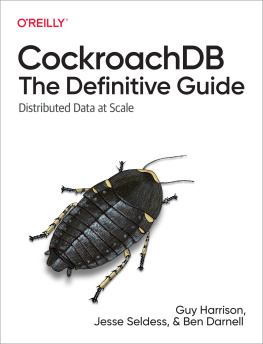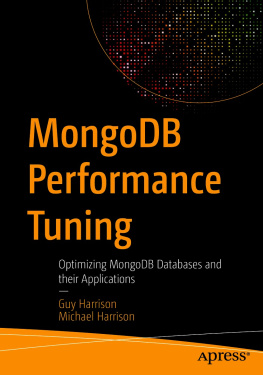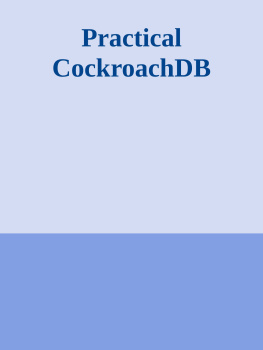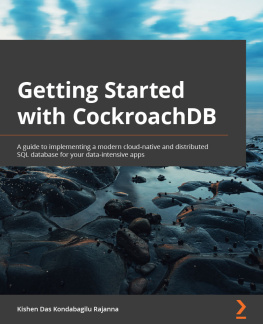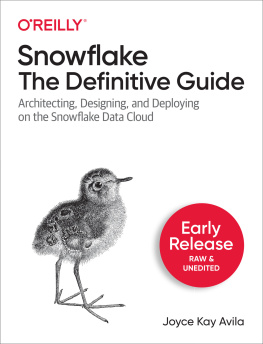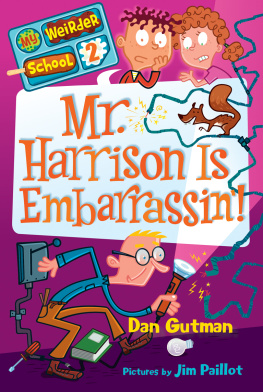Guy Harrison - CockroachDB
Here you can read online Guy Harrison - CockroachDB full text of the book (entire story) in english for free. Download pdf and epub, get meaning, cover and reviews about this ebook. year: 2022, publisher: OReilly Media, genre: Home and family. Description of the work, (preface) as well as reviews are available. Best literature library LitArk.com created for fans of good reading and offers a wide selection of genres:
Romance novel
Science fiction
Adventure
Detective
Science
History
Home and family
Prose
Art
Politics
Computer
Non-fiction
Religion
Business
Children
Humor
Choose a favorite category and find really read worthwhile books. Enjoy immersion in the world of imagination, feel the emotions of the characters or learn something new for yourself, make an fascinating discovery.
- Book:CockroachDB
- Author:
- Publisher:OReilly Media
- Genre:
- Year:2022
- Rating:5 / 5
- Favourites:Add to favourites
- Your mark:
- 100
- 1
- 2
- 3
- 4
- 5
CockroachDB: summary, description and annotation
We offer to read an annotation, description, summary or preface (depends on what the author of the book "CockroachDB" wrote himself). If you haven't found the necessary information about the book — write in the comments, we will try to find it.
CockroachDB — read online for free the complete book (whole text) full work
Below is the text of the book, divided by pages. System saving the place of the last page read, allows you to conveniently read the book "CockroachDB" online for free, without having to search again every time where you left off. Put a bookmark, and you can go to the page where you finished reading at any time.
Font size:
Interval:
Bookmark:
DoorDash has been able to use CockroachDB to forklift-migrate and scale numerous workloads without having to rewrite applicationsonly small index or schema changes. This definitive resource is for both new engineers and seasoned veterans who want to learn CockroachDBs internals, deployment, and capabilities. Engineers looking to build and run scalable applications using CockroachDB would do well to read this book.
Sean Chittenden, Core Infrastructure, DoorDash
Modern distributed SQL systems bring together the best ideas of databases from the last 50 years: the relational model, strong consistency guarantees, and elastic scalability. This trinity is what modern applications need to stay in the game.
Andy Pavlo, Associate Professor of Databases, Carnegie-Mellon University; Cofounder, OtterTune
Distributed SQL databases combine the benefits of the relational database model with native support for distributed cloud architecture. CockroachDB pairs the transactional consistency of standard SQL with elastic scalability, multiregion and multicloud deployment, and high levels of fault tolerance and availability. Developers thinking about their next-generation enterprise application requirements will find this guide very timely.
Matt Aslett, VP & Research Director, Ventana Research
We know that sometimes (stuff) happens. And, at scale, (stuff) is always happening.
Spencer Kimball, Cofounder, Cockroach Labs (as mentioned in the CockroachDB: The Definitive Guide preface)
by Guy Harrison , Jesse Seldess , and Ben Darnell
Copyright 2022 OReilly Media, Inc. All rights reserved.
Printed in the United States of America.
Published by OReilly Media, Inc. , 1005 Gravenstein Highway North, Sebastopol, CA 95472.
OReilly books may be purchased for educational, business, or sales promotional use. Online editions are also available for most titles (http://oreilly.com). For more information, contact our corporate/institutional sales department: 800-998-9938 or corporate@oreilly.com.
- Acquisitions Editor: Andy Kwan
- Development Editor: Angela Rufino
- Production Editor: Christopher Faucher
- Copyeditor: Stephanie English
- Proofreader: Kim Cofer
- Indexer: nSight, Inc.
- Interior Designer: David Futato
- Cover Designer: Karen Montgomery
- Illustrator: Kate Dullea
- April 2022: First Edition
- 2022-04-08: First Release
See http://oreilly.com/catalog/errata.csp?isbn=9781098100247 for release details.
The OReilly logo is a registered trademark of OReilly Media, Inc. CockroachDB: The Definitive Guide, the cover image, and related trade dress are trademarks of OReilly Media, Inc.
The views expressed in this work are those of the authors and do not represent the publishers views. While the publisher and the authors have used good faith efforts to ensure that the information and instructions contained in this work are accurate, the publisher and the authors disclaim all responsibility for errors or omissions, including without limitation responsibility for damages resulting from the use of or reliance on this work. Use of the information and instructions contained in this work is at your own risk. If any code samples or other technology this work contains or describes is subject to open source licenses or the intellectual property rights of others, it is your responsibility to ensure that your use thereof complies with such licenses and/or rights.
This work is part of a collaboration between OReilly and Cockroach Labs. See our statement of editorial independence.
978-1-098-10024-7
[LSI]
Welcome to CockroachDB: The Definitive Guide, and thank you for being here! With this book, we want to help you learn to build and deploy applications with CockroachDB, the distributed SQL database built for the cloud.
First, the question everyone asks: Why the name CockroachDB?
One immutable fact of engineering is that things break. At large enough scale, things are breaking all the time. The kinds of failures that might happen once a year on a single machine become daily occurrences when youre running hundreds of shards. A system that aspires to handle large scale must treat fault tolerance as a core responsibility. This was one of the key insights of Googles MapReduce framework. By requiring all computation to fit within a relatively restrictive framework, it became straightforward for the system to automatically rerun the necessary pieces of work after a failure.
We believe that this is how it should be: highly available replication should be the default state of a database from day one, not the result of painstaking configuration work. And looking ahead to day two (or day two hundred), the database must be able to grow along with the application so that runaway success is a cause for celebration, not panic.
When we set out to build a relational database from scratch, we wanted to bring consistency, native resilience, data locality, and massive scale to modern cloud applications. Our vision was of a system able to colonize any resource that you gave it onto the public cloud and then relentlessly optimize itself. A database that would use available space and reach equilibrium across a coordinated set of globally distributed nodes so that it would not only incorporate new resources, butif a machine or data center or even an entire region went downthe database would simply equalize the remaining available resources.
We aimed to build a database that would be globally ubiquitous and impossible to eradicatejust like periplaneta brunnea, the pesky common cockroach. And so CockroachDB was born.
CockroachDBs origin is a tale of necessity. Quite literally, Spencer Kimball, Peter Mattis, and I, Ben Darnell, set out to build the relational database that we ourselves needed.
After working together at Google, the three of us went in different directions for a while. Eventually we ended up back together (along with Spencers brother Andy, a Microsoft SQL Server veteran) at a startup called Viewfinder, building an application for photo organization and social sharing. We, of course, hoped it would be successful, so we wanted to build for scale. After all, as Spencer says, Sometimes shit happens. And, at scale, shits always happening.
It turns out that, given the history of that project, we didnt do well enough to ever need massive scalability, but we wanted to plan for it from the beginning. We also didnt want to lock ourselves into a monolithic database, sharding MySQL or anything like that. We had been down that road before and knew it didnt lead where we wanted to go. This left us looking at NoSQL options as the best alternative and eventually we settled on DynamoDB.
DynamoDB ticked a lot of boxes: its scalable, its fast, its predictable. Its very similar to Bigtable, which I had used as the backend for Google Reader while I was at Google. And so, on paper at least, we really liked that model. But as we got experience with it, we realized we had a couple of fundamental problems with NoSQL.
The biggest one was we found that we really needed secondary indexes. The Bigtable/DynamoDB model is really primary keys only; theres no concept of secondary indexes. To get them, we had to build our own partial implementation of transactions on top of DynamoDB, which was workable. Once we were using this system, however, we found a subsequent problem. DynamoDB on its own is very fast, predictable, and scalablebut once you start doing things that combine multiple records, as we were doing with our secondary indexes, then things got difficult.
Font size:
Interval:
Bookmark:
Similar books «CockroachDB»
Look at similar books to CockroachDB. We have selected literature similar in name and meaning in the hope of providing readers with more options to find new, interesting, not yet read works.
Discussion, reviews of the book CockroachDB and just readers' own opinions. Leave your comments, write what you think about the work, its meaning or the main characters. Specify what exactly you liked and what you didn't like, and why you think so.

